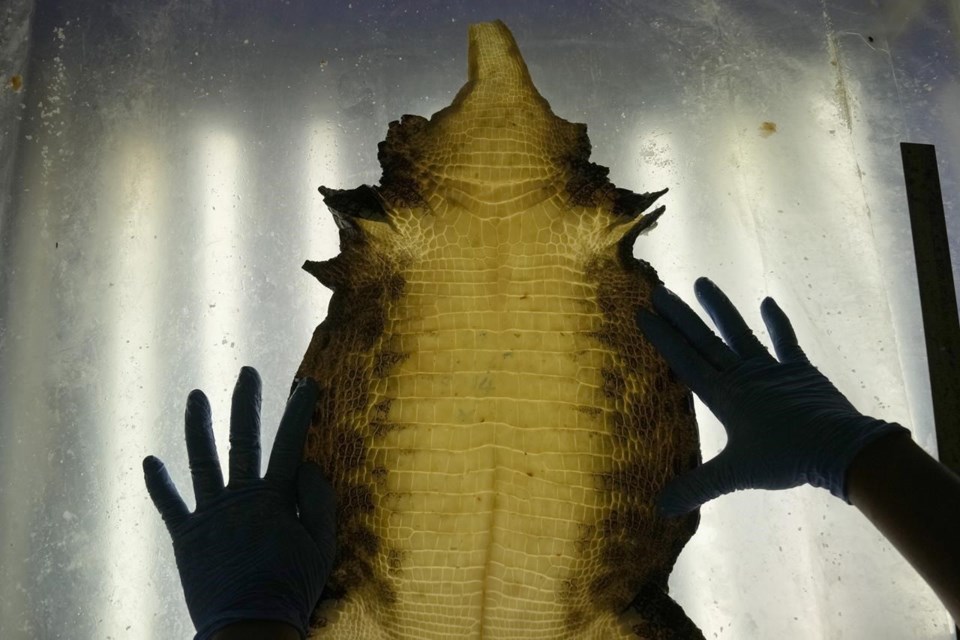SRI RACHA, Thailand (AP) — Crocodile farmers in Thailand are suggesting a novel approach to saving the country’s dwindling number of endangered wild crocodiles. They want to relax regulations on cross-border trade of the reptiles and their parts to boost demand for products made from ones raised in captivity.
With only about 100 Siamese crocodiles estimated to be living in the wild in Thailand, the species is technically teetering on local extinction. Crocodile farmers, meanwhile, are raising millions of the animals in captivity, but also not faring so well. The coronavirus pandemic devastated sales of their products due to an almost complete halt in the lucrative market of visiting tourists.
In response, Thailand’s crocodile industry, whose $200 million in annual sales plunged nearly 90% during the pandemic, is promoting a two-track solution it hopes can benefit itself as well as the reptile species. In addition to seeking a relaxation of tight regulations on international trade of their products, they are spearheading an effort to restock Siamese crocodiles in the wild.
Although the industry had its roots in the capture of wild crocodiles, breeders and traders argue that a successful and well-regulated farming business can help rebuild the wild crocodile population.
Advocates of easing trade rules believe the successful breeding of Siamese crocodiles on farms means it’s no longer cost effective to hunt them in the wild, and a thriving commercial industry will help fund conservation projects.
Thailand will propose a relaxation of the rules on the trade in Siamese crocodiles at next week’s meeting in Panama of the 184-nation CITES, the Convention on International Trade in Endangered Species of Wild Fauna and Flora.
The Thai proposal seeks to change the current listing of Siamese crocodiles from Appendix I, a category with extremely strict trade rules for species under threat, to Appendix II, with more relaxed rules that place less regulatory burden on buyers who import the products.
Yosapong Temsiripong, the head of the Thai Crocodile Farm Association and owner of the Sriracha Moda Farm, said this would help revive the battered industry, allowing easier export of meat to countries such as China and, more importantly, crocodile skins to big overseas fashion brands for handbags and shoes. Relaxed rules would help Thailand compete with the United States, Zimbabwe and Australia, which are major exporters of crocodile species that are not in the category of most endangered.
“The last two years, during the pandemic, the crocodile industry was greatly affected as tourism is the main source of our income. When there were no tourists coming, our business suffered greatly,” Yosapong said. “Our exports were also affected. We are hoping that if we can downlist the Siamese crocodile, we can then enter more markets and our products can be accepted by global brands.”
Wild Siamese crocodiles, which were once found in abundance in slow-moving rivers, streams and lakes in Thailand, Laos and Cambodia, were decimated by the late 1990s due to uncontrolled hunting and trading, as well as by economic development that shrank their natural habitats. It’s believed that only about 400 Siamese crocodiles remain in the wild, mostly in Cambodia.
Promoting commercial farming and crocodile conservation are compatible goals, said Bancha Sukkaew, deputy director-general of Thailand’s Fisheries Department.
“The species remains as a protected species. Those allowed to be sold and exported have to be from farms. So we can guarantee that trade will be made from farms only. Secondly, we have plans to manage protected areas and plans to release crocodiles into the wild which have been approved to be carried out annually."
Thai authorities are committed to protecting the wild population, with plans to increase it from about 100 now to 200 over the next 10 years, he said.
Previous proposals to ease trading rules for Siamese crocodiles, however, have been rejected.
Steven Platt, a herpetologist from the U.S.-based Wildlife Conservation Society, said more should be done to save Thailand’s wild Siamese crocodiles before opening the door to increased trade. Such efforts should include a more robust crocodile release program, he said.
Neighboring Cambodia and Laos are leading the effort to increase the wild populations with regular release programs, said Platt, who has spent years working on crocodile conservation. The two countries are believed to have stable and viable populations, which some experts say is not the case in Thailand. Thailand's release of 50 crocodiles between 2006 and 2019 is relatively small compared to Laos, where around 70 crocodiles were released this year alone.
“Thailand has the best system of national parks, real protected areas that function. They are well governed. They are well managed. They have scientific staff, enforcement staff, and that’s unique in the region. And there’s ... a tremendous potential for Thailand to take the lead in Siamese crocodile conservation," he said. “And we’re just not seeing that.”
Tassanee Vejpongsa, The Associated Press




